-
Paper Information
- Paper Submission
-
Journal Information
- About This Journal
- Editorial Board
- Current Issue
- Archive
- Author Guidelines
- Contact Us
Physical Chemistry
p-ISSN: 2167-7042 e-ISSN: 2167-7069
2017; 7(3): 70-74
doi:10.5923/j.pc.20170703.03

A Study of Nanoparticle Sizes and Their Distribution along a Main Road in Ulaanbaatar City
G. Oyungerel1, G. Batdemberel2, Sh. Chadraabal2, D. Sangaa3
1School of Mathematics and Natural Sciences, Mongolian State University of Education, Ulaanbaatar, Mongolia
2School of Applied Sciences, Mongolian University of Science and Technology, Ulaanbaatar, Mongolia
3Institute of Physics and Technology, Mongolian Academy of Sciences, Mongolia
Correspondence to: G. Oyungerel, School of Mathematics and Natural Sciences, Mongolian State University of Education, Ulaanbaatar, Mongolia.
| Email: |  |
Copyright © 2017 Scientific & Academic Publishing. All Rights Reserved.
This work is licensed under the Creative Commons Attribution International License (CC BY).
http://creativecommons.org/licenses/by/4.0/

The size and distribution of particles along a main road in Ulaanbaatar city are studied by Photon Cross Correlation Spectroscopy (PCCS) NANOPHOX (Sympatec GmbH, Germany). The mean diameter, the size distribution range, the specific surface area of the aerosol particles are found to be equal to 1.1-2.5 μm, 74 nm-4.0 μm and 2.38-5.43 m2/cm3, respectively. On the other hand, the particles distribution is Gaussian with density of 0.02-8.15 (q3lg) in the range of 790 nm-3.8 μm. However, nanoparticles with diameters less than 74 nm was not observed. The results reveal that samples contain 0.02% in volume ultrafine particles or nanoparticles in the range of 74-100 nm, 83.73% fine particles (PM2.5) in the range of 100 nm-2.4 μm and 16.25% coarse particles (PM10) in the range of 2.4-4.0 μm. It can be concluded that a high percentage of PM2.5 particles is present in an aerosol sample along a main road of Ulaanbaatar city.
Keywords: Aerosol particle, Particle size distribution, Suspension, PCCS, Nanophox
Cite this paper: G. Oyungerel, G. Batdemberel, Sh. Chadraabal, D. Sangaa, A Study of Nanoparticle Sizes and Their Distribution along a Main Road in Ulaanbaatar City, Physical Chemistry, Vol. 7 No. 3, 2017, pp. 70-74. doi: 10.5923/j.pc.20170703.03.
Article Outline
1. Introduction
- Aerosols are important in atmospheric science and air pollution. Dust, smoke, fume, haze, and mist are common terms for aerosols. Nanoparticle aerosols play an important role in the environment, in global climate, in human health, in material processing and in nanotechnology. However, the knowledge of their physical and chemical properties of fume aerosol is critical [1].The science of atmospheric nanoparticle aerosols is relatively new and their poisonous physical and chemical properties have not fully been understood [1]. Particle size is one of the most important properties of indoor and outdoor particulate matter (PM). Information on particle size is also of importance in selecting a proper air pollution control technology [2]. Particle sizes cover a range from a few nanometers up to more than 100 μm, according to their size, several classes of particles are distinguished in literature. The most important fractions are commonly referred to as ultrafine (particle diameter smaller than 100 nm), fine (smaller than 2.5 μm) and coarse particle (between 2.5 and 10 μm). Some time, ultrafine particles are called nanoparticles [3]. The main sources of air pollution in Ulaanbaatar are household heating systems, power plants, car emissions, as well as dust emissions. Therefore, the study of nanoparticle aerosols has become an important aspect for human health and environment [4].According to a study of the Ministry of Environment, sulphur content in the air is higher in the winter and sulphur dioxide gets higher than normal standards in summer and spring. Also, particulate matter (PM) is the main reason for air pollution of the city. On the basis of PM Ulaanbaatar seems to be the highest polluted city in the world [4]. In order to study air pollution, aerosol particle size, its size distribution, density, morphology as well as composition must be determined systematically. Also it is very important to prioritize various programs which aim to reduce air pollution, and to evaluate them.This article is focused on the investigation of particle sizes and their distribution along a main road in the Ulaanbaatar city.
2. Experimental
2.1. Sample Preparation
- Samples were selected from 12 points; also, all samples were prepared on 25th January 2011, because air pollution reached high level and had side effects on human health. When snow melted, it (snow) had become black suspension and made our research easy. Therefore, it was not necessary to inlet particles by special apparatus. Particles of suspension were filtered by a 39 μm filter to remove large particles. Then 20 ml of suspension was added to 80 ml of distilled water. For the preparation of a homogeneous suspension an Ultrasonic Cell Disruptor KS-900F (voltage 230W/50Hz, impulse 30%, amplitude 50%) was used. Samples were sonicated for 15 min.
2.2. Particle Size Distribution Analysis
- Particle size and size distribution analysis of suspensions was done on Photon Cross Correlation Spectroscopy (PCCS) (Sympatec GmbH, Germany). Samples (2 ml) were put into uvette (Eppendorf Uvette, Sympatec Item No. NZ0020). Then the uvette was placed in temperature-controlled bath, filled by clean water filtered by a 0.22 μm filter. It has to be orthogonal to the incoming laser beam of 632.8 nm wavelength. The water level should be 3/4 of the bath height. The data was calculated by WINDOX 5 [5].
3. Results and Discussion
- The particle size and cumulative distribution of samples are shown in Table 1.
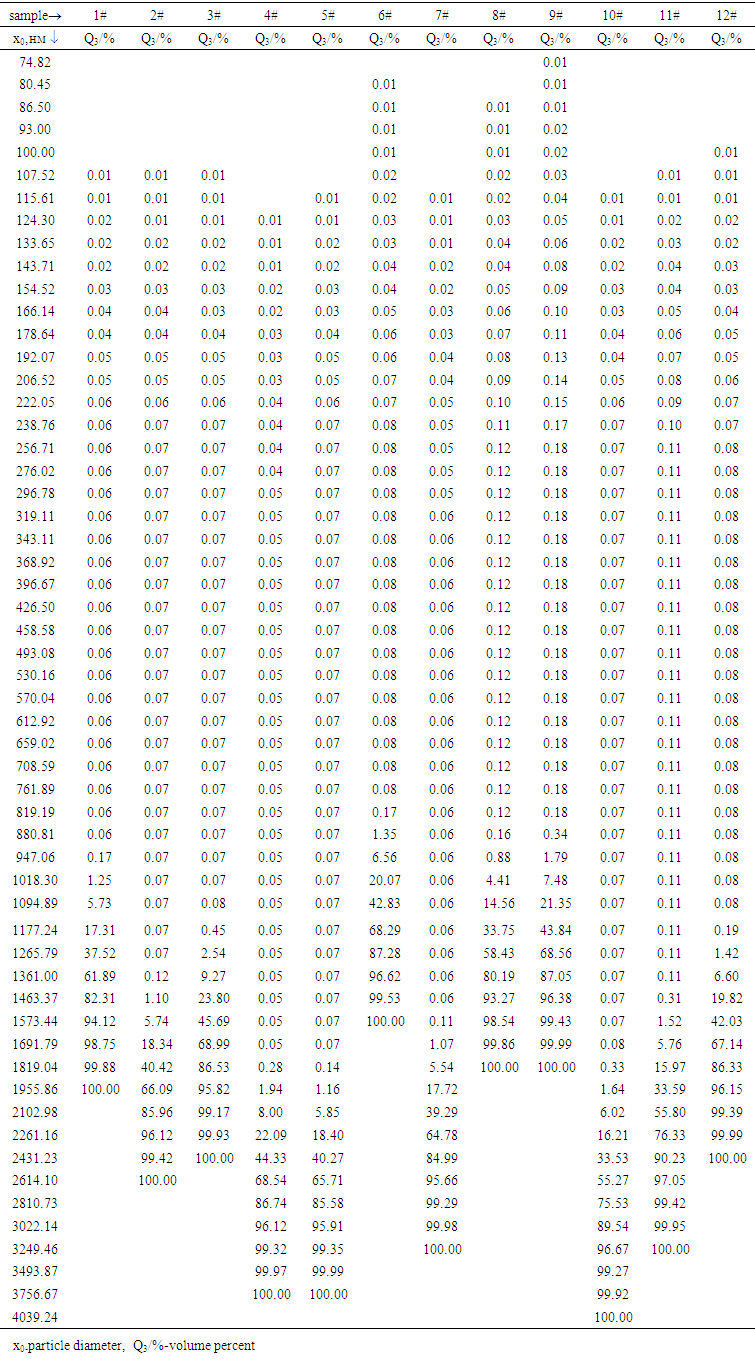 | Table 1. The particle size and cumulative distribution of samples |
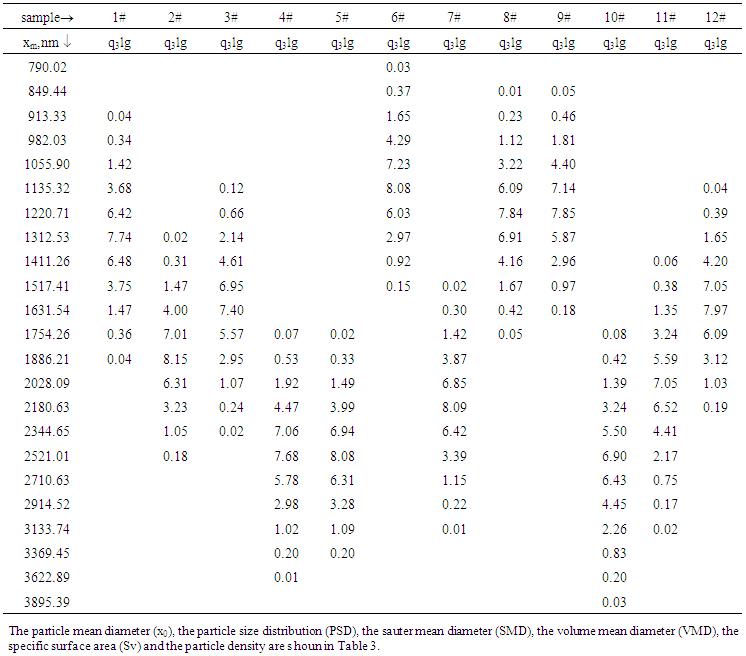 | Table 2. Particle density of all samples |
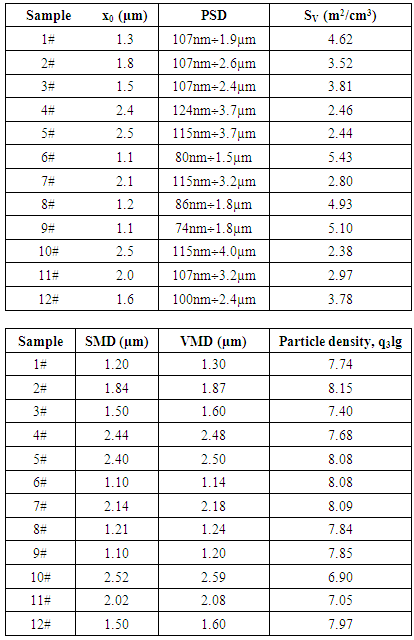 | Table 3. Values of Particle parameters |
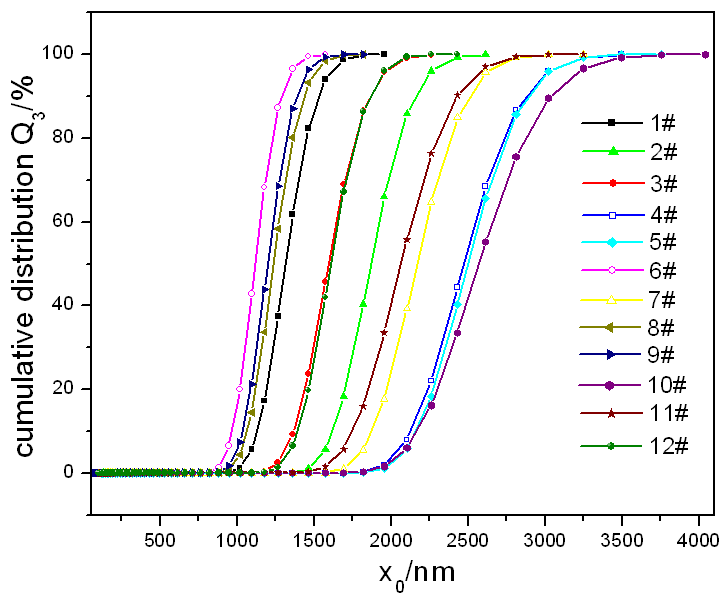 | Figure 1. Cumulative distribution of particles |
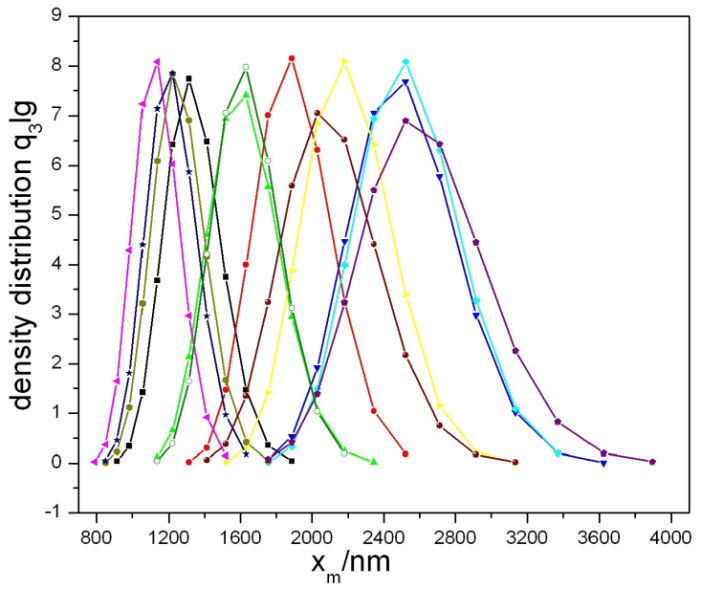 | Figure 2. Density distribution of particles |
4. Conclusions
- The aim of this work was to investigate particle sizes and their distribution of aerosols along a main in Ulaanbaatar city. As a result, it can be concluded that1. Particle mean diameters are from 1.1 to 2.5 μm, particle size distribution is in the range of 74 nm-4.0 μm, Sv is 2.38-5.43 m2/cm3.2. Particles with diameter less than 74 nm were not detected.3. The particle distribution is Gaussian with density 0.02-8.15 (q3lg) in the range of 790 nm-3.8 μm. 4. Ultrafine particles or nanoparticles (0.02% volume percent) were found in the range of 74-100 nm, 83.73% fine particles (PM2.5) in the range of 100 nm-2.4 μm and 16.25% coarse particles (PM10) in the range of 2.4-4.0 μm.5. Aerosols along the main road have high content of PM 2.5 particles.
ACKNOWLEDGEMENTS
- The authors are grateful to the Science and Technology Foundation of Mongolia for providing the financial support covering the research work “Investigation of natural and technological nanoparticles by The Photon Cross Correlation Spectroscopy (NANOPHOX)”.
 Abstract
Abstract Reference
Reference Full-Text PDF
Full-Text PDF Full-text HTML
Full-text HTML